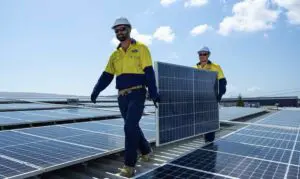Last week, another coal-burning utility announced that a significant purchase of wind power will benefit ratepayers. This is the third contract to deliver over 200 megawatts (MW) of electricity from Oklahoma and Kansas wind farms to benefit the Southeast states. Alabama was first, now Georgia will see lower and more stable electricity prices through wind power purchases. Both utilities Georgia Power and Alabama Power report that the wind power contracts provide cost-savings for their customers.
So, can other Southeast states benefit as well?
Yes. This exciting change in energy supply choices for the Southeast comes after a series of fundamental policy decisions, and the resulting years of experience with renewable energy that followed. Wind power has become available at low prices around the world through market support of a U.S. federal production tax credit, Renewable Portfolio Standards in U.S states, and feed-in-tariffs in Europe.
In addition, the US opened the transmission system to allow generators to compete with one another. The Georgia Power and Alabama Power deals both rely on the wind farm owners scheduling the needed transmission, and paying the owners of that existing transmission.
Wind energy all over the place?!
Since the mid-1990s, when wind power additions started coming by the hundreds of megawatts, utility operators and their regulators have learned they can adapt to use renewable energy, even though it is predictably variable. Superstitions about wind and solar generation have fallen as wind power levels have risen to supply more than 15 per cent of electricity in three states and three European countries.
Who is minding the store?
State governments, the investor-owned utilities they regulate, and consumer-owned utilities make more of the decisions about new (and old) power plants and where our energy comes from.
When those decisions are made with all the concerns relevant to the public interest, and allow new information from suppliers offering alternatives with lower costs, wind power comes up a winner. While Georgia Power found their way to buy wind energy based only on the power price, many states have recognized a longer list of benefits from wind and solar.
With jobs on everyone’s mind, it is important to ask if your state’s energy policies are helping create new jobs. Fellow UCS analyst Laura Wisland summarized some clean tech job creation reports, and the surprising politics.
There is great potential for change in how the Southeast gets its supplies of electricity. The region has a history of heavy reliance on producing electricity with coal imported from outside the Southeast. When UCS made a nationwide survey of coal imports, five Southeast states (GA, NC, FL, AL, SC) each sent over $1 billion per year out of state. Renewable energy and energy efficiency create a lot more jobs, and lower priced electricity.
How can you get these benefits?
Mike Jacobs is a senior energy analyst in the Climate & Energy Program at the Union of Concerned Scientists
This article was originally published on the Union of Concerned Scientist’s Equation blog. Reproduced with permission








